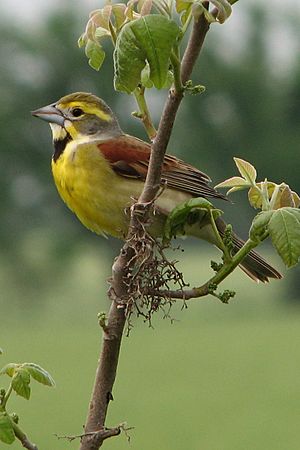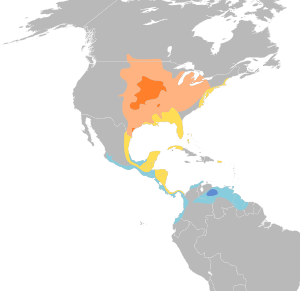Dickcissel facts for kids
Quick facts for kids Dickcissel |
|
|---|---|
 |
|
| Male in breeding plumage | |
| Conservation status | |
| Scientific classification | |
| Genus: |
Spiza
|
| Species: |
americana
|
 |
|
| Synonyms | |
|
Emberiza townsendi |
|
The dickcissel (Spiza americana) is a small American bird that eats seeds. It belongs to the family Cardinalidae. These birds make their homes in the grassy prairies of the Midwestern United States. When winter comes, they fly south to Central America, northern Colombia, and northern Venezuela. The dickcissel is the only bird in its genus called Spiza.
Contents
About the Dickcissel's Name
The dickcissel was first officially described in 1789 by a German scientist named Johann Friedrich Gmelin. He gave it the scientific name Emberiza americana. Later, in 1824, a French scientist named Charles Lucien Bonaparte created the genus Spiza for this bird. The name Spiza comes from an Ancient Greek word for a common type of finch.
The dickcissel is part of a group of birds in the Cardinalidae family. This group also includes birds like Amaurospiza, Cyanocompsa, Cyanoloxia, and Passerina. The dickcissel is special because it's the only one in this group that doesn't have blue colors in its feathers. Even though it looks different from other birds in its family, its strong, cone-shaped beak shows it's related to them.
The Mystery of "Townsend's Dickcissel"
There's a famous bird specimen often called Spiza townsendi. It was found on May 11, 1833, by John Kirk Townsend in Pennsylvania. This bird is very unique because no other bird exactly like it has ever been found. For a long time, people wondered if it was a completely different species or even an extinct type of bird. However, in 2014, a photo of a similar bird in Ontario showed that they still exist.
This bird is often called "Townsend's dickcissel" to honor the person who found it. Most scientists now believe it's not a separate species. Instead, it's likely a rare color variant of the regular dickcissel. This means it's a dickcissel with a genetic change that affects its feather color.
When the "Townsend's dickcissel" was first found, its yellow and buff colors were pure white. Its olive parts were grey, and its brown wings looked reddish. This suggests that the bird was missing the yellow pigments in its feathers. It's similar to how albinism happens in some animals, but it affects different colors. Even though this bird seemed healthy, it's very rare to find another one like it.
Scientists think that the dickcissel's color system might be very sensitive. This means that most genetic changes to its colors might not allow the bird to survive. So, the "Townsend's dickcissel" might be one of the very few that did. It's like how some rare color changes in pet birds, like canaries, have only happened a few times over many years.
Some people also thought "Townsend's dickcissel" might be a hybrid (a mix of two different species). However, this seems unlikely because the bird looks exactly like a dickcissel in its body shape. Also, it doesn't have any blue colors, which would be expected if it had mixed with a blue bird like an indigo bunting. More studies, possibly using ancient DNA from the specimen, could help solve this mystery for sure.
What Dickcissels Look Like

Dickcissels have a large, light-colored bill. They have a yellow stripe above their eyes. Their upper body is brownish with black stripes on their back. Their wings are dark, and they have a rusty patch on their shoulders. Their belly is light-colored.
Adult male dickcissels have a black patch on their throat and a yellow chest. Their cheeks and the top of their head are grey. This pattern is very bright during the breeding season. It makes them look a bit like an eastern meadowlark. Female dickcissels and young birds have brownish cheeks and heads. They look a bit like house sparrows and have stripes on their sides.
When they fly, dickcissels make a low, buzzing sound like fpppt. When a male bird sits on a high spot in a field, its song is a sharp dick dick followed by a buzzed cissel. Some people describe it as skee-dlees chis chis chis or dick dick ciss ciss ciss.
Measurements:
- Length: 5.5-6.3 inches (14-16 cm)
- Weight: 0.9-1.4 ounces (25.6-38.4 g)
- Wingspan: 9.8-10.2 inches (24.8-26 cm)
Where Dickcissels Live
Dickcissels breed in fields across the midwest of North America. After the breeding season, they migrate in large groups. They fly to southern Mexico, Central America, and northern South America for the winter. Sometimes, they can be seen far away from their usual areas. Between 1966 and 2015, the number of dickcissels decreased by more than 1.5% in the northern parts of their breeding range and across the Midwestern United States.
How Dickcissels Live
Breeding Habits
These birds arrive at their breeding grounds quite late in the spring, usually in May or early June. They build their nests close to the ground in thick grasses or small bushes. They might also nest up to 3 or 4 feet (90-120 cm) high in larger bushes and trees.
Male dickcissels can have many mates, sometimes up to six. However, most males only attract one or two mates, and some don't find any at all. If these "bachelor" males survive until the next summer, they will try again to attract females. The male and female dickcissels only stay together to raise one group of chicks. This makes dickcissels one of the few songbirds where males often have multiple partners. When they leave for their winter homes around early August, their partnership ends.
What They Eat
Dickcissels look for food on the ground or in fields. They mostly eat insects and seeds. When it's not nesting season, they usually feed in large groups. Farmers in some areas consider them a nuisance because these large groups can eat a lot of cultivated grains.
The number of dickcissels in different areas often changes a lot. In the early 1800s, dickcissels spread eastward. They started living in New England and the mid-Atlantic states. But by the end of that century, they disappeared from those areas. Both their spread and their disappearance were likely due to changes in how people used the land.
- Sibley, David Allen (2003): The Sibley Field Guide to Birds of Eastern North America. Alfred A. Knopf, New York. ISBN: 0-679-45120-X
See also
 In Spanish: Arrocero americano para niños
In Spanish: Arrocero americano para niños




